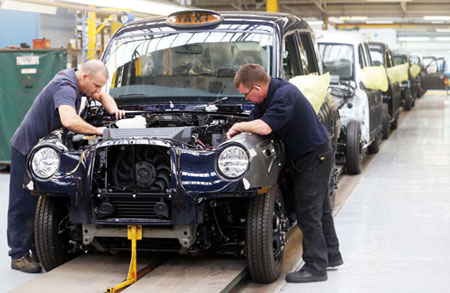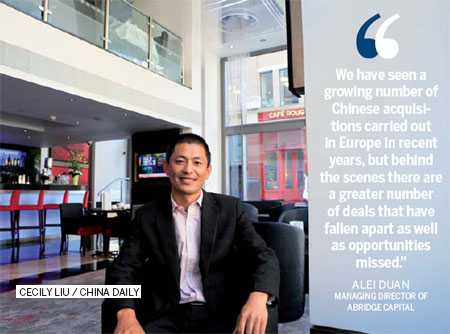Riding the wave of big bargain buy-ups
|
Chinese companies make their mark in Europe with flurry of M&A deals Weetabix cereal, MG3 hatchbacks, London black cabs, the Lloyds of London building, and red wine from Bordeaux: They do have some things in common. All were cash-strapped and are now enjoying a fresh lease of life, thanks to Chinese companies. Many of these brands are iconic names that have been around for ages. Though some are now controlled by Chinese companies there has been hardly any difference in the quality, look, feel and availability of the products, experts say. More importantly, the timely Chinese investment has helped local communities by preserving and creating more jobs in an otherwise bleak environment. Across Europe, be it Germany, Italy, Belgium, the UK or France, investment by Chinese companies has been rising steadily and moved on to broader sectors like innovation and luxury. According to Thomson Reuters, M&A deals involving Chinese companies rose 12.5 percent year on year to $172.7 billion (128 billion euros) during the first three quarters of this year. During the same period the value of cross-border Chinese M&As grew 10.5 percent year on year to $67.5 billion.
Yingni Lu,director of the London-based consultancy firm EcoLeap, saysChinese companies are now changing tack in Europe and looking at deals that will give them access to the key technologies and technical know-how of their European targets. To some extent, that also explains the increased interest in European M&A deals among Chinese companies, experts say. According to data provided by stock market research firm Dealogic, the value of Chinese acquisitions in Europe reached $10.5 billion last year, compared with $259 million in 2002. The number of Chinese deals in Europe reached 78 last year, compared with just 11 in 2002, according to Dealogic. Germany is still one of the top choices for M&A deals by Chinese companies due to its wealth of engineering talent and premium technology.[Read more]………………………………………………………………………………………………………………………………………………………………
The report saysa growing number of Chinese private equity firms are now shifting their focus onto overseas mergers and acquisitions, as opportunities to invest in China's capital market diminish. "Though it is still early days, this shift has a big influence on deal-making between Chinese and European companies in the years ahead,"the report says."It may make the M&A arena even more competitive and also bring more investment opportunities to those watching out for them,"the report says. On top of deals already completed, the true level of acquisition interests is perhaps better reflected in the number of potential deals being speculated on in recent months. Examples include the Chinese lender ICBC's interest in acquiring Standard Bank's commodity trading arm in London, and Qingdao D&D Investment Group's interest in machine tools manufacturer 600 Group, to name just two.[Read more] Good fit Experts feel that Chinese companies have been able to manage integration relatively smoothly. As an example they cite the successful acquisition of British automaker MG Motor UK by SAIC Motor Corp.
Martin Uhlarik, design director of MG Motor UK, says the renewed production of cars after the SAIC acquisition is like a rebirth, as fresh capital infusion has allowed the company to flourish internationally. "MG is kind of enjoying a renaissance. It's not every day that a designer gets a chance to be part of that. Not many brands are being reborn with such a big investment." In 2005, SAIC bought MG after the 89-year-old company went into liquidation. Three years later, MG began a small-scale assembly of limited edition MGs from Chinese-made kits at Longbridge, near Birmingham. MG introduced its first car, the MG6 Magnette sedan, in the UK in April 2011, which was also the first all-new MG in 16 years. With the MG team's help, SAIC has also started producing MG cars in China, for the local market. [Read more] Charged up Another example of a European business enjoying great growth after receiving fresh injection of capital from its new Chinese owners is Dynex, a semiconductor manufacturer based in Lincoln, England. In 2008, Zhuzhou CSR Times Electric acquired a 75 percent stake of Dynex, and has since helped the British company build a 12-million-pound ($19 million; 14 million euro) new R&D center to focus on developing insulated-gate bipolar transistor technology. Dynex's R&D team also increased from 12 to about 40, including those from the Zhuzhou company on secondment. Dynex has also helped Zhuzhou CSR to build a new factory in China, which specializes in producing low-voltage IGBT semiconductors, while production of high voltage IGBT semiconductors remains with Dynex in Lincoln. "The strategy Zhuzhou CSR Times Electric discussed with us is to retain our operations here in Lincoln," says Paul Taylor, who has been CEO of Dynex since 2004. [Read more] |
| Chinese firms 'slow to deal'
Companies may be missing out on some of the best acquisitions in Europe, expert says
Duan says this is partly due to their distance from the market and unfamiliarity with it, which often means spending a long time on research and making decisions. "We have seen a growing number of Chinese acquisitions carried out in Europe in recent years, but behind the scenes there are a greater number of deals that have fallen apart as well as opportunities missed." Duan says Chinese acquisitions in Europe grew significantly after many European companies fell into financial difficulties due to the eurozone crisis, but major competitors for these assets are US companies. As Chinese companies are less experienced at making acquisitions in Europe, they are often not very decisive about whether to offer a deal, or at what price point to offer, he says. "There have been some cases my team worked on, where Chinese buyers couldn't fit in with the speed of deals required by the market, which means the assets were sold to US buyers or other buyers who could act quickly," he says. Duan says US competitors are more culturally similar to UK companies, which can put Chinese buyers at a disadvantage. Another worry about Chinese buyers is intellectual property protection, he says, adding that he once worked on a deal that failed because the UK seller feared its technology might be copied in China. [Read more] |
| Takeover turned into great makeover
Chinese parent helps British machine tool maker take the high road to success Tony Bannan still remembers the sinking feeling he had three years ago, when he learnt that his machine tool business was being taken over by a Chinese company.
"It was not exactly a great position to be in. Luckily I was not rigid and was open to persuasion. There were two individuals that particularly had my confidence - the chairman and the executive director, who made me understand the advantages of the deal," says Bannan, the 49-year old chief executive of the Manchester-based Precision Technologies Group. Three years later, it is a different story.Chongqing Machinery & Electric Co, the Chinese state-owned firm that took control of Precision Technologies in a 20 million pound ($32 million; 24 million euros) deal, has not only breathed new life into the ailing machine tool company, but has also steered it toward a new growth path, focused largely on high technology. Contrary to fears that the Chinese takeover would lead to job losses, employee numbers at Precision have risen from 157 to 216 in the past three years. Bannan says most of the research and development work conducted by Precision is on advanced machine tools, something that would not have been possible without support and funding from the Chinese company.[Read more] |
|
Related readings: |
|
Chinese companies snapping up overseas brands Private firms can bloom globally |
Chinese firms eye strong EU brands, survey says Chinese enterprises look to expand investment in Europe |
| Two Views |
|
Investment wisdom that lasts forever By Nicholas Emmerson New wave of mid-sized private Chinese companies in Europe shows the way Investments by big Chinese companies in Europe have made the headlines in recent years, but it is the entrance of mid-sized private Chinese companies into the continent through acquisitions that is now gaining attention.
These companies, motivated by taking advanced technology and know-how back to China as well as gaining sales channels in Europe, are very focused on acquisitions, often moving ahead of state-owned and mega private Chinese companies. These private companies are particularly keen to access the wealth of opportunity at the so-called mid-market level, where smaller European companies, often manufacturers, are eager to do deals in Europe with Chinese companies. In particular, investments in and strategic acquisitions of European manufacturing companies are starting to happen, and this trend looks set to continue. Chinese and European manufacturing companies in the same business sector can often quickly understand each other and may already be working together. An initial small investment can lead to closer cooperation, giving the Chinese manufacturer the opportunity to build its reputation with its partner and in the relevant market before making larger strategic acquisitions later.[Read more] The author is a partner at Gateley LLP, a law firm based in the UK. |
On the right road to acquisition By Wu Jiangang Chinese, European companies should strive to build more trust and focus on long-term development For the past several months, Asia's richest man Li Ka-shing has been selling most of his real estate and businesses in China and buying British companies related to public facilities. If not so long ago Chinese investments in Africa and South America were regarded as more compelling, for the past two years it seems China's participation in acquisitions in Europe has been attracting greater attention. Statistics confirm there has been a sudden increase in Chinese acquisitions in Europe. In 2011, China's acquisition investment in Europe totaled $10.4 billion (7.7 billion euros), accounting for 34 percent of its total overseas acquisitions that year, compared with 10 percent in 2010, while the percentage of acquisition investment in North and South America decreased from 34 percent to 27 percent. Europe became China's largest acquisition investment destination. In 2012, Chinese acquisitions in Europe grew by 20 percent and the amount spent was for the first time bigger than that of European acquisitions in China. Again, Europe was the region with the largest acquisition activity for China. Chinese enterprises are attracted to the European acquisition market mainly for two reasons. The first is that European enterprises are walking out of the shadow of the sovereign debt crisis, but the prices of their equities are still low, which makes the stock market attractive for foreign investments. Though the American stock market has rebounded significantly after the financial crisis of 2008, the European stock market has been under-performing.[Read more] The author is a lecturer at the Management School of Shanghai University and a research fellow at the China Europe International Business School, Lujiazui International Finance Research Center. |






